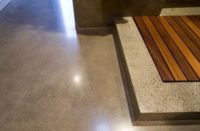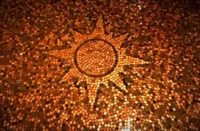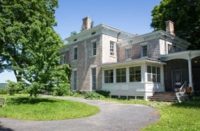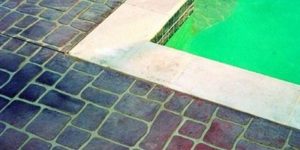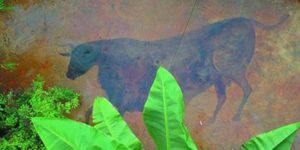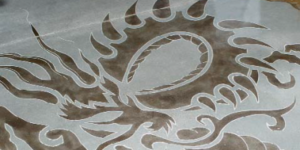
It wouldn’t do for a roller coaster with a name like the Bourbon Street Fireball to have anything less than a hot logo. Alexander Darmstaedter, an experienced designer formerly with Ameripolish, recently stenciled a logo for the ride in Bowie, Maryland. After working for years on stencils and vinyl decals for concrete and other commercial design work, he started his own business, Concrete Art Studio, providing stencils and design services for contractors, and installing special projects himself.
Last year, Darmstaedter, based in Northwest Arkansas, was contacted by a contractor who asked him to create the stencil. This contractor then backed out of the job and handed it over to Darmstaedter and his son, Nicholous, who then installed the large, three-layer multicolor stencil at the entrance for the Fireball. Darmstaedter likes Ameripolish dye, but in this case he chose SS DYEnamic exterior/interior (manufactured by SurfKoat) because it had a more of a color selection and much less residual dye to clean off. He applied SS Supreme 2500 Plus clear sealer over the top.

The stencil was a challenging project. At 15 feet across and involving eight colors, the stencil had to be applied in five layers. Because of the size of the cutting machine Darmstaedter uses, he had to cut up to six pieces for each layer of the stencil. “I was working with 22 4-by-8-foot pieces of stencil, and I had to make sure all the pieces would line up with each other in the end,” he says. Not only that, the work was done in the middle of June. “It was 100 degrees out there!” Darmstaedter says.
Six Flags placed a brand new circular piece of concrete where the logo would go. It cured for a month, then was ground to 400 grit. The park built an 8-foot-tall plywood wall around the concrete circle to keep the prying eyes and feet of the public off the project while the installation took place. That heated things up even more. “It was so hot in there,” he recalls. “It was like a sauna. I don’t think I’ve ever sweated so much in my life.”
Luckily, the stencil took only two days to apply, but heat was not Darmstaedter’s only problem. It rained the first night, big time. “The main part of the design was done the first day, but for it to be protected, we had to put a clear coat on the top, and you can’t just roll it on,” he explains. “You have to spray it on, otherwise it’ll smear the dye underneath.”

Darmstaedter was able to apply enough clear coat to protect the design for the night. To keep out the water, they covered the circle with tarps. In the morning, the tarps held so much rain the circle looked like a swimming pool.
“The tarps had held enough water that they were bowed all the way down to the floor, almost touching the design,” he says. “We had to poke holes in the tarps and bring big rolling garbage cans in, to let the water drain out, so we could take the tarps off the top. It was kind of an ordeal.”
In the end, all was well, the logo came out beautifully, and Six Flags is very happy. The next several months proved its durability, and the park has initiated internal discussions to plan for more of these concrete logos at the parks in the future.
